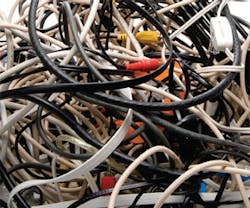Managing Your Cable Infrastructure
Because your building’s cabling and wiring lie quietly out of sight, they should not be out of mind. Your cable infrastructure adds value for tenants and occupants, and, like all building systems, it requires ongoing attention and management, from installation to removal, disposal, and recycling of cables.
Keeping up-to-date records with databases, spreadsheets, and/or drawings of installed cabling protects your asset by making it easier to troubleshoot and repair existing cabling, as well as plan new installations. Ever-faster transmission speeds and larger quantities of data mean that older cabling is often replaced by newer types, whether or not a space has been configured for a new use or a new tenant. Any plan being developed to install new cables should refer to the record of what is already in place.
Unused cabling from prior installations can increase the complexity and labor cost of future installations. It can also lead to excessive weight on ceiling grids as well as other cables, potentially degrading signal strength. Cabling in plenums can also restrict airflow.
A survey of your current cable infrastructure provides a starting point. Any cable that is not rated for its current use in your building should be removed. For example, all cables in risers and vertical shafts must have the CMR rating designating cables with insulation and jacketing designed to prevent the spread of fire from floor to floor. Cables installed without conduit in plenums and ducts must be rated CMP, which carries flame-spread resistance as well as low-smoke and low-toxin producing properties.
Cable that is rated but unused may also require removal. Due to fire safety concerns, since 2002 the National Electrical Code (NEC) has called for removal of abandoned cable, which is defined as any cable that is not terminated at both ends at equipment or a connector, and that is not tagged for future use. The 2008 edition of the NEC clarifies that audio cable is included in the “installed supply circuits and interconnecting cables” to which the removal requirements apply, says Mark Earley, NFPA chief electrical engineer.
Tagging Cable for Future Use
The only alternative in the NEC to removal of abandoned cable is tagging it for future use, but this procedure was not designed to encourage what Earley calls an approach of “let’s just go buy a bunch of tags rather than take the stuff out.” NEC stipulates that the tags be sufficiently durable to withstand the environment in which they are used. In addition, cables should have tags at each end, and the tags must include the intended date and a description of the future use, as well as the date when the tag was attached.
If your jurisdiction has adopted NEC 2002 or later, you could be subject to the abandoned cable requirement. As a result, BOMA International recommends that leases should include language requiring tenants to remove cable abandoned during the lease term. License agreements with service providers should also require removal of wires upon contract termination.
Abandoned cable is also on the radar of insurers. According to Liz Christopher of Nationwide Mutual Insurance, the company likes to see old cable tagged as out of service, but does not necessarily require its removal and does not have policy language on abandoned cable. Underwriters do question the age of wiring and electrical updates for new business and renewal analysis, but do not generally address cable unless a loss control survey or other information in the file indicates the presence of abandoned or untagged cable.
David Cohen, senior director of real estate for commercial insurance at Fireman’s Fund, says that the company makes its underwriters aware of abandoned cable issues, but it has not had any claims or loss experience, and the company currently has no exclusions or limitations in its policy language.
Chris Olson ([email protected]) is editor in chief of Buildings.
